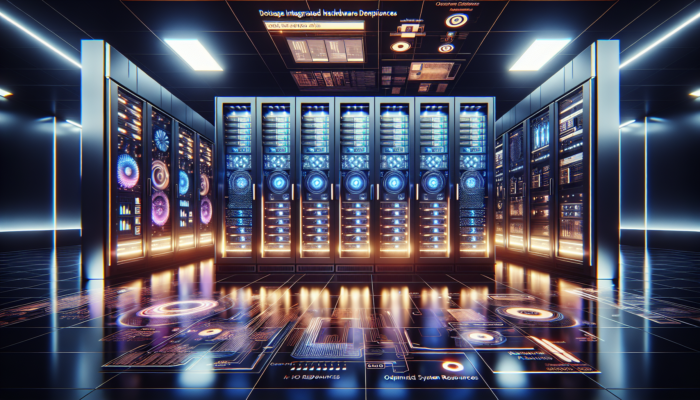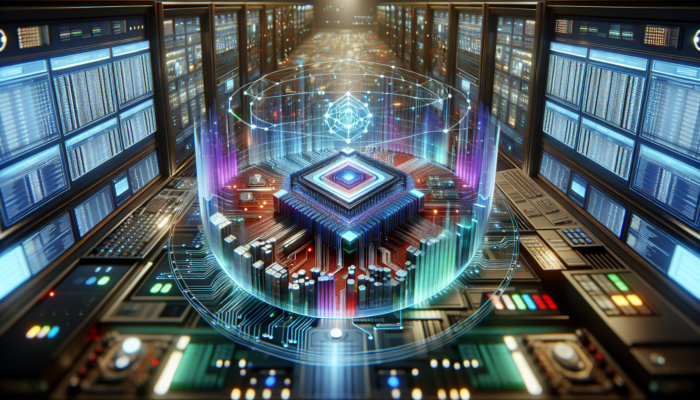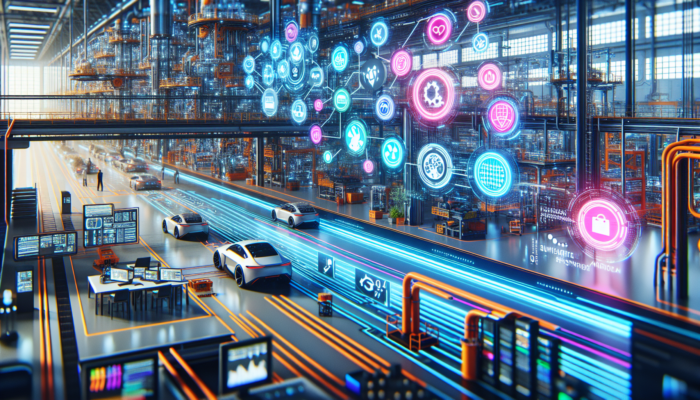In the current climate of rapidly advancing technology, the integration of hardware components has become indispensable for enhancing system performance. The amalgamation of both physical and virtual elements not only facilitates seamless operation but also unlocks a multitude of advantages for businesses and individuals alike. This article explores the significance of hardware integration and its profound impact on system performance, while elucidating the various benefits it provides.
Understanding the Concept of Hardware Integration for Optimal Performance
Hardware integration refers to the intricate process of amalgamating various physical components, including processors, memory modules, storage devices, and peripherals, into a seamlessly functioning system. This method involves the harmonious incorporation of hardware elements to work together efficiently, thereby enabling optimal performance and resource efficiency. Such integration can occur at multiple levels, ranging from individual computer systems to the hardware within specific devices or complex machines.
The essence of hardware integration lies in its ability to unify disparate components of a system, allowing them to communicate and interact effectively. By synergising processors, memory modules, storage devices, and peripherals, businesses can establish a cohesive system that operates with remarkable efficiency and maximises performance. This level of integration ensures that each hardware component collaborates seamlessly, effectively eliminating potential bottlenecks or inefficiencies that could impede system operations.
Maximising System Performance through Effective Hardware Integration

- Optimising Efficiency for Enhanced Performance: By integrating hardware components, businesses can achieve efficient utilisation of system resources. This process involves optimising the hardware configuration, which streamlines operations, reduces bottlenecks, and ultimately leads to improved overall efficiency.
When hardware components are successfully integrated, they work together efficiently, thereby maximising the utilisation of system resources. By optimising the hardware configuration, businesses can identify and eliminate redundant components or processes that might otherwise slow down system operations. This effective use of resources not only enhances overall system performance but also boosts productivity across various functions.
- Boosting Scalability for Future Growth: The integration of hardware provides the necessary flexibility to scale the system’s capabilities up or down in alignment with the evolving needs of the business. This adaptability ensures that the system can manage increased workload demands without sacrificing performance.
Scalability is a crucial component of system performance, particularly in today’s fast-paced business landscape. Hardware integration empowers businesses to effortlessly adjust their systems as demands evolve. Whether it involves adding more processors, increasing memory capacity, or expanding storage capabilities, this integration provides the necessary flexibility to accommodate growing operational workloads without compromising on performance.
- Minimising Latency for Faster Operations: The integration of hardware components significantly reduces latency, enabling quicker data processing and real-time interactions. This reduction is particularly critical in applications such as online gaming, cloud computing, and financial trading, where milliseconds can make a significant difference.
Latency refers to the delays experienced in data processing or transmission. In applications demanding real-time interactions or rapid data processing, minimising latency is essential. Through effective hardware integration, system components can be optimised to reduce delays, thereby ensuring swifter data processing. This is especially relevant in sectors such as online gaming, where even the slightest delay can detract from the user experience.
- Enhancing Reliability through Redundant Systems: Hardware integration facilitates the establishment of redundant systems, guaranteeing that the failure of one component does not result in complete system failure. This high degree of reliability minimises downtime and ensures uninterrupted operation.
Reliability is of paramount importance for any system, as unexpected downtime can lead to significant financial losses and tarnish an organisation’s reputation. Hardware integration enables the creation of redundant systems, where backup components can seamlessly take over in the event of a failure. By implementing duplicate hardware elements, businesses can ensure continuous operation and significantly mitigate the effects of potential failures.
- Strengthening Security with Integrated Systems: Integrated hardware systems can offer enhanced security features, such as hardware-level encryption and secure boot processes. These features provide an additional layer of protection for sensitive data, significantly reducing the risk of unauthorised access and cyber threats.
Security remains a top concern for businesses regarding their systems and sensitive data. Hardware integration enhances security measures by incorporating features like hardware-level encryption, secure boot processes, and built-in security protocols. These safeguards add an extra layer of defence to protect sensitive data, making it increasingly difficult for unauthorised individuals to gain access or launch malicious attacks.
Essential Considerations for Effective Hardware Integration
To fully leverage the potential of hardware integration and achieve optimal system performance, several key considerations must be taken into account:
1. Ensuring Compatibility and Interoperability Among Components
When integrating hardware components, it is imperative to verify compatibility and interoperability among various elements. Mismatched components or incompatible interfaces can hinder performance and lead to system malfunctions. Conducting comprehensive compatibility testing and adhering to industry standards is essential to mitigate such issues.
Compatibility and interoperability are critical factors to consider during the hardware integration process. It is vital to confirm that the various hardware components can function together seamlessly. Conducting thorough compatibility testing and adhering to established industry standards can significantly reduce the risk of encountering issues arising from incompatible components or interfaces.
2. Efficient Resource Allocation for Balanced Performance

Effective resource allocation is fundamental to achieving optimal system performance. By thoroughly analysing workload requirements and distributing resources accordingly, businesses can avert resource bottlenecks and guarantee balanced utilisation across the system.
Resource allocation is a pivotal aspect influencing system performance. By carefully analysing workload demands, businesses can establish optimal resource distribution for elements such as CPU, memory, and storage. This ensures that each component receives the necessary resources, preventing bottlenecks and promoting balanced resource utilisation throughout the entire system.
3. Future-Proofing Hardware Integrations for Long-Term Success
In a swiftly changing technological landscape, it is crucial to consider future needs when integrating hardware components. Choosing flexible and upgradable hardware solutions allows businesses to stay abreast of emerging technologies and maintain compatibility with future advancements.
Future-proofing is essential to avoid the need for frequent hardware upgrades. When integrating hardware components, businesses should contemplate potential future advancements and shifts in technology. Opting for flexible and upgradable hardware solutions enables organisations to adapt to new technologies without necessitating a complete system overhaul.
4. Importance of Maintenance and Support for Integrated Systems
Regular maintenance and timely support are vital for sustaining the performance of integrated hardware systems. Ensuring access to reliable technical support and implementing a well-structured maintenance plan can help businesses address any arising issues promptly, thereby minimising downtime.
<pConsistent maintenance and prompt support are crucial for the smooth operation of integrated hardware systems. Establishing a comprehensive maintenance plan and having access to dependable technical support can enable businesses to deal with hardware issues swiftly. This proactive approach to maintenance minimises downtime and ensures that the system operates at peak performance levels.
Exploring Real-World Applications of Hardware Integration Across Industries

The influence of hardware integration is evident across diverse industries and sectors. Below are a few noteworthy examples:
1. Revolutionising the Internet of Things (IoT)
In IoT applications, hardware integration is crucial for establishing connections between physical devices and facilitating seamless communication with the virtual realm. Integrated hardware systems enable efficient data collection, processing, and real-time monitoring, which are essential for advancing smart city initiatives, industrial automation, and home automation.
In the realm of IoT applications, hardware integration is vital for linking physical devices and enabling communication with the digital world. Integrated hardware systems effectively collect data from various sensors, process it efficiently, and facilitate real-time monitoring. This functionality plays a significant role in numerous sectors, including the development of smart city initiatives, industrial automation, and home automation solutions.
2. Empowering Cloud Computing Solutions
Cloud computing heavily relies on hardware integration to deliver computing resources and services to users over the internet. Integrated server systems, networking components, and storage devices collaborate effectively to ensure smooth data processing, storage, and retrieval, allowing businesses to scale their operations and meet growing demands.
Hardware integration forms the backbone of cloud computing, enabling the delivery of computing resources and services over the internet. Integrated server systems, networking components, and storage devices work cohesively to guarantee efficient data processing, storage, and retrieval. This level of integration empowers businesses to scale their operations effectively, adapting to the increasing demands of cloud computing.
3. Enhancing Experiences in Virtual Reality (VR) and Augmented Reality (AR)
The immersive experiences provided by VR and AR applications depend significantly on high-performance hardware integration. Integrated graphics processing units (GPUs), sensors, and display devices collaborate to deliver realistic visuals and seamless interactivity, enriching user experiences in gaming, training, and simulation environments.
Hardware integration is fundamental for creating immersive experiences in VR and AR applications. The synergy between integrated graphics processing units (GPUs), sensors, and display devices is essential for providing realistic visuals and smooth interactivity. This level of integration dramatically enhances user experiences across various fields, including gaming, training, and simulation applications.
Harnessing the Power of Hardware Integration for Enhanced System Performance
The integration of hardware components is pivotal in shaping system performance, enabling businesses and individuals to fully leverage the advantages of a seamless blend of physical and virtual elements. By optimising resource allocation, enhancing efficiency, and bolstering reliability, integrated hardware systems facilitate improved scalability, reduced latency, and heightened security. However, ensuring compatibility, anticipating future requirements, and establishing robust maintenance plans are critical to unlocking the complete potential of hardware integration. Embracing this transformative approach to system architecture opens new avenues for innovation while harnessing the true power of technology.
1. Defining Hardware Integration: What Does It Entail?
Hardware integration involves the systematic process of merging various physical components, including processors, memory modules, storage devices, and peripherals, into a cohesive system. This method ensures that hardware elements work together harmoniously, facilitating optimal performance and efficiency.
2. Ways in Which Hardware Integration Enhances System Performance
Hardware integration enhances system performance in numerous ways:
- Optimised Efficiency: The integration of hardware components allows for the effective utilisation of system resources, streamlining operations and minimising bottlenecks.
- Scalability: Hardware integration provides the flexibility to adjust the system’s capabilities according to the evolving needs of the business, without compromising performance.
- Reduced Latency: The integration of hardware components can significantly lower latency, enabling faster data processing and real-time interactions.
- Improved Reliability: Hardware integration facilitates the establishment of redundant systems, ensuring uninterrupted operation even in the event of component failure.
3. Key Factors to Consider for Successful Hardware Integration
To achieve maximum system performance through hardware integration, it is important to consider the following:
- Compatibility and Interoperability: Ensuring that different hardware components are compatible and can work seamlessly together.
- Optimal Resource Allocation: Analysing workload requirements and allocating resources effectively to prevent bottlenecks and ensure balanced utilisation.
- Future-Proofing: Considering future requirements and opting for flexible and upgradable hardware solutions to adapt to emerging technologies.
- Maintenance and Support: Establishing a comprehensive maintenance plan and ensuring access to dependable technical support for prompt issue resolution.
4. Practical Applications of Hardware Integration Across Various Industries
Hardware integration is widely utilised in multiple sectors, including:
- Internet of Things (IoT): Facilitating seamless communication between physical devices and the virtual world for smart city initiatives, industrial automation, and home automation.
- Cloud Computing: Delivering computing resources and services over the internet through integrated server systems, networking components, and storage devices.
- Virtual Reality (VR) and Augmented Reality (AR): Creating immersive experiences through integrated graphics processing units (GPUs), sensors, and display devices in gaming, training, and simulation environments.
Originally posted 2023-04-13 01:06:36.